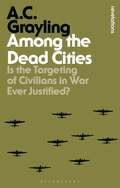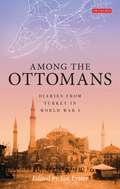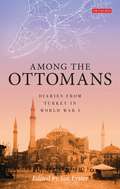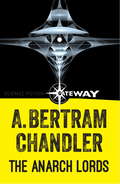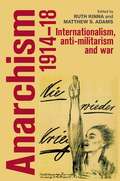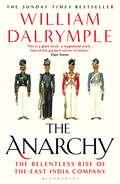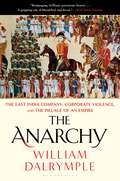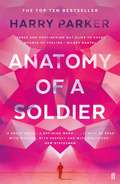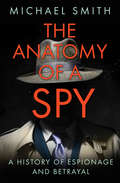- Table View
- List View
Amiens 1918: The Last Great Battle
by James McWilliams R James SteelOn 8 August 1918, the Allied forces launched the surprise attack that heralded the end of the First World War. With skill and daring, 21 divisions of men breached the German lines, supported by 500 tanks and 1,000 aircraft. This book considers the successes and failures of both sides in this conflict.
Among the Dead Cities: Is the Targeting of Civilians in War Ever Justified? (Bloomsbury Revelations Series)
by A. C. GraylingBritain and the USA carried out a massive bombing offensive against the cities of Germany and Japan in the course of the Second World War, which ended with the destruction of Hamburg, Dresden, Tokyo, Hiroshima and Nagasaki. Was the bombing of civilian targets justified by the necessities of war? Or was it, in fact, a crime against humanity? How should we, the descendants of the Allies who won the victory in that war, reply to the moral challenge of the descendants of those whose cities were targeted? A.C. Grayling looks at the stands people took, both for and against, and crucially asks what are the lessons that we can learn for today about how people should behave in a world of tension and moral confusion, of terrorism and fragile democracies. Among the Dead Cities is both a lucid and revealing work of modern history and an investigation of conscience into one of the last remaining controversies of that time.
Among the Dead Cities: Is the Targeting of Civilians in War Ever Justified? (Bloomsbury Revelations)
by A. C. GraylingIs it ever right to target civilians in a time of war? Or do the ends sometimes justify the means? The twentieth century - the age of 'total war' - marked the first time that civilian populations came to be seen as legitimate military targets. At this policy's most terrible extreme came the dropping of the atomic bomb on Hiroshima and Nagasaki but it is an issue that remains relevant today with the needs of the 'War on Terror' used to justify the use of drone strikes. In Amongst the Dead Cities, A.C. Grayling explores these moral issues in all their complexity with a detailed examination of the Allied bombing of German cities during World War 2. Considering the cases for and against the area bombing and the experiences of the bombed and the bombers, Grayling asks: was the targeting of civilians in Germany a crime? Now available in the Bloomsbury Revelations series, the book includes a new afterword by the author considering the issues in light of later conflicts up to the present day.
Among the Dead Cities: Is the Targeting of Civilians in War Ever Justified? (Bloomsbury Revelations)
by A. C. GraylingIs it ever right to target civilians in a time of war? Or do the ends sometimes justify the means? The twentieth century - the age of 'total war' - marked the first time that civilian populations came to be seen as legitimate military targets. At this policy's most terrible extreme came the dropping of the atomic bomb on Hiroshima and Nagasaki but it is an issue that remains relevant today with the needs of the 'War on Terror' used to justify the use of drone strikes. In Amongst the Dead Cities, A.C. Grayling explores these moral issues in all their complexity with a detailed examination of the Allied bombing of German cities during World War 2. Considering the cases for and against the area bombing and the experiences of the bombed and the bombers, Grayling asks: was the targeting of civilians in Germany a crime? Now available in the Bloomsbury Revelations series, the book includes a new afterword by the author considering the issues in light of later conflicts up to the present day.
Among the Headhunters: An Extraordinary World War II Story of Survival in the Burmese Jungle
by Robert LymanFlying the notorious "Hump" route between India and China in 1943, a twin-engine plane suffered mechanical failure and crashed in a dense mountain jungle, deep within Japanese-held territory. Among the passengers and crew were celebrated CBS journalist Eric Sevareid, an OSS operative who was also a Soviet double agent, and General Joseph "Vinegar Joe" Stilwell's personal political adviser. Against the odds, all but one of the twenty-one people aboard the doomed aircraft survived-it remains the largest civilian evacuation of an aircraft by parachute. But they fell from the frying pan into the fire.Disentangling themselves from their parachutes, the shocked survivors discovered that they had arrived in wild country dominated by a tribe with a special reason to hate white men. The Nagas were notorious headhunters who routinely practiced slavery and human sacrifice, their specialty being the removal of enemy heads. Japanese soldiers lay close by, too, with their own brand of hatred for Americans.Among the Headhunters tells-for the first time-the incredible true story of the adventures of these men among the Naga warriors, their sustenance from the air by the USAAF, and their ultimate rescue. It is also a story of two very different worlds colliding-young Americans, exuberant apostles of their country's vast industrial democracy, coming face-to-face with the Naga, an ancient tribe determined to preserve its local power based on headhunting and slaving.
Among the Ottomans: Diaries from Turkey in World War I
by Ian LysterDuring World War One, the Ottoman Empire, one of the largest and longest-lasting empires in history, faced severe challenges to its structure and existence, which eventually resulted in its dissolution. 'Among The Ottomans' introduces two unique diary accounts written by two generations of the same family in the declining years of the Ottoman Empire.Written in the heart of the crumbling Ottoman Empire, Marie Lyster's World War One diaries describe the political and social climate of Constantinople as Allied troops swept through Turkey, wreaking havoc on the country's infrastructure and forcing residents, regardless of their national affiliations, to endure the hardships of war. Just 200 miles away in the Dardanelles, her son Henry was fighting with the Allies against the Turks. Following the Allied retreat in 1915, he was posted to Salonika in northern Greece, where he worked with the 'Comitajis' as they fought the Bulgarians. Later, as the Military Governor of Eastern Thrace, he witnessed the rise of Turkish Nationalism and the struggle for control of the fragmented pieces of the fallen empire. Published for the first time, these two diaries provide an unprecedented account of the Great War's impact across generations and geographical borders and a unique insight into the final years of the Ottoman Empire.
Among the Ottomans: Diaries from Turkey in World War I
by Ian LysterDuring World War One, the Ottoman Empire, one of the largest and longest-lasting empires in history, faced severe challenges to its structure and existence, which eventually resulted in its dissolution. "Among The Ottomans" introduces two unique diary accounts written by two generations of the same family in the declining years of the Ottoman Empire. Written in the heart of the crumbling Ottoman Empire, Marie Lyster's World War One diaries describe the political and social climate of Constantinople as Allied troops swept through Turkey, wreaking havoc on the country's infrastructure and forcing residents, regardless of their national affiliations, to endure the hardships of war. Just 200 miles away in the Dardanelles, her son Henry was fighting with the Allies against the Turks. Following the Allied retreat in 1915, he was posted to Salonika in northern Greece, where he worked with the 'Comitajis' as they fought the Bulgarians. Later, as the Military Governor of Eastern Thrace, he witnessed the rise of Turkish Nationalism and the struggle for control of the fragmented pieces of the fallen empire.Published for the first time, these two diaries provide an unprecedented account of the Great War's impact across generations and geographical borders and a unique insight into the final years of the Ottoman Empire.
Among You: The Extraordinary True Story of a Soldier Broken by War
by Jake WoodAmong You is the gripping real-life story of a soldier serving on the front line in Iraq and Afghanistan, and an unforgettable, unflinching account of the effects of post-traumatic stress disorder.Jake Wood lives parallel lives: encased in the glass tower of an international investment bank by day, he is also a dedicated TA soldier who serves on the front line during the invasion of Iraq, later returning to the war zone to conduct surveillance on insurgents. Disillusioned with the dullness and amorality of the banking world, he escapes back to the army for a third tour of duty. But in Afghanistan he discovers the savage, dehumanising effects that war has on both the body and the mind. Diagnosed with chronic PTSD on his return, he must now fight the last enemy – himself – in order to exorcise the ghosts of his past.Brutally honest and beautifully written, Among You brings home the harsh reality of front-line combat in Iraq and Afghanistan, and the courage of the troops who risk their lives for their country, as well as revealing the devastating after-effects of service.
Amongst the Marines: The Untold Story
by Steven PreeceSteven Preece was a Royal Marine Commando from 1983 to 1990, serving first at entry-level and then as a lance-corporal. Amongst the Marines is Steven's first-hand account of his years as an elite soldier, focusing directly on the excessive and often shocking lifestyle of the Marines during this time, and impact this had on his own personality and behaviour.Preece fulfilled his childhood ambition by earning the coveted Green Beret when he was 18. He was unaware, however, of the brutal rite of passage that awaited him and all the other 'pieces of skin' [new recruits]. Violence in the Marines, as Steven discovered, was not limited to the battlefield but a continual part of a pervasive culture of bullying and aggression. It did not take long for Preece to be accepted into this culture and to adopt it as his own. On duty he was fit, committed and loyal, while off duty he displayed a mammoth capacity for drinking, fighting and womanising. On home leave, Steven found it increasingly hard to adapt to civilian life. His drinking sessions in local pubs frequently ended in fights with the locals and even in violence against members of his own family. Preece earned a reputation amongst his fellow Marines for pranks and dangerous behaviour; and this eventually led him to be court-maritialled. To his relief and surprise, however, Preece was fully acquitted by the court.Amongst the Marines is an unflinching exposé of the culture of the Marines, from foul practical jokes and rough justice to the off-duty orgies of drink, sex and violence. It is a no-holds-barred account of the many shocking incidents Preece witnessed and participated in, from his first day as a new recruit to his exit from the Marines with his reputation intact and his scores settled once and for all.
The Amritsar Massacre: The Untold Story of One Fateful Day
by Nick LloydAt approximately 5:10pm on 13 April 1919, Brigadier-General 'Rex' Dyer, led a small party of soldiers through the centre of Amritsar into a walled garden known as the Jallianwala Bagh. He had been informed that an illegal political meeting was taking place and had come to disperse it. Dyer's men entered the garden and immediately opened fire upon the huge crowd that had gathered there. 379 people were killed and at least 1,000 more were wounded in what has became known as the Amritsar Massacre. The massacre is the most infamous British atrocity in the history of British rule in India. Opening fire on an unarmed gathering of men, women and children, it was the most brutal incident of its kind, fatally weakening the British position in India and uniting the people of the subcontinent against their colonial masters. It is commonly seen as the turning point in India's struggle for freedom, an episode that has become enshrined in Indian national myth and which is still recounted to generations of school children as a moment of inexplicable imperial barbarity. This important new book aims to dispel the myths and misconceptions surrounding the massacre and challenges the conventional historiography by offering a defence of the British Raj and the decisions taken in 1919. Nick Lloyd begins his retelling with Britain's hopes for a new age of collaboration and reform in 1917 and 1918 and then explains the growth of nationalist discontent, before taking the reader into the claustrophobic streets of the Punjab in April 1919 when violence broke out. Part historical account of a bloody massacre, part history of an empire in a period of great change, The Amritsar Massacre will appeal to both history enthusiasts and the general reader.
Analogies at War: Korea, Munich, Dien Bien Phu, and the Vietnam Decisions of 1965
by Yuen Foong KhongFrom World War I to Operation Desert Storm, American policymakers have repeatedly invoked the "lessons of history" as they contemplated taking their nation to war. Do these historical analogies actually shape policy, or are they primarily tools of political justification? Yuen Foong Khong argues that leaders use analogies not merely to justify policies but also to perform specific cognitive and information-processing tasks essential to political decision-making. Khong identifies what these tasks are and shows how they can be used to explain the U.S. decision to intervene in Vietnam. Relying on interviews with senior officials and on recently declassified documents, the author demonstrates with a precision not attained by previous studies that the three most important analogies of the Vietnam era--Korea, Munich, and Dien Bien Phu--can account for America's Vietnam choices. A special contribution is the author's use of cognitive social psychology to support his argument about how humans analogize and to explain why policymakers often use analogies poorly.
Analyzing Strategic Nuclear Policy (PDF)
by Charles L. GlaserWith sweeping changes in the Soviet Union and East Europe having shaken core assumptions of U.S. defense policy, it is time to reassess basic questions of American nuclear strategy and force requirements. In a comprehensive analysis of these issues, Charles Glaser argues that even before the recent easing of tension with the Soviet Union, the United States should have revised its nuclear strategy, rejecting deterrent threats that require the ability to destroy Soviet nuclear forces and forgoing entirely efforts to limit damage if all-out nuclear war occurs. Changes in the Soviet Union, suggests Glaser, may be best viewed as creating an opportunity to make revisions that are more than twenty years overdue. Glaser's provocative work is organized in three parts. "The Questions behind the Questions" evaluates the basic factual and theoretical disputes that underlie disagreements about U.S. nuclear weapons policy. "Alternative Nuclear Worlds" compares "mutual assured destruction capabilities" (MAD)--a world in which both superpowers' societies are highly vulnerable to nuclear retaliation--to the basic alternatives: mutual perfect defenses, U.S. superiority, and nuclear disarmament. Would any basic alternatives be preferable to MAD? Drawing on the earlier sections of the book, "Decisions in MAD" addresses key choices facing American decision makers.Originally published in 1990.The Princeton Legacy Library uses the latest print-on-demand technology to again make available previously out-of-print books from the distinguished backlist of Princeton University Press. These editions preserve the original texts of these important books while presenting them in durable paperback and hardcover editions. The goal of the Princeton Legacy Library is to vastly increase access to the rich scholarly heritage found in the thousands of books published by Princeton University Press since its founding in 1905.
Anam
by André DaoMoving from 1930s Hanoi through a series of never-ending wars and displacements to Saigon, Paris, Melbourne and Cambridge, this is a novel about memory and inheritance, colonialism and belonging, home and exile.Born to a Vietnamese family based in Melbourne, the narrator is haunted by the story of his grandfather whose ten-year imprisonment by the Communist government in Vietnam’s notorious Chi Hoa prison looms large over his own place in the world and his choice to become a human rights lawyer. As he oscillates between identities of his Australian upbringing and his Vietnamese heritage, it is the death of his grandfather in a Parisian suburb and the birth of his daughter that crystallize the strands of thought that have shaped his life.André Dao’s Anam blends fiction and essay, theory and everyday life to imagine that which has been repressed, left out, and forgotten by archives and by families. As the grandson sifts through letters, photographs, government documents and memories, he has his own family to think about: a partner and an infant daughter. Is there a way to remember the past that creates a future for them as well? Or does coming home always involve a certain amount of forgetting?
The Anarch Lords (John Grimes)
by A. Bertram ChandlerHis wild career as a space pirate ended, Grimes faced his toughest assignment - he was "punished" by being made governor of the anarchists' own planet! John Grimes, living legend of the spaceways, had been in and out of some cosmic catastrophes but this threatened to reach his luck's ultimate breaking point!An influx of planetary refugees had made that world a paradise of cheap labor and the original anarchist colonists had become such masters of wealth that no mere outsider could hope to dictate "law and order" to them. They had their own ideas which included slavery, treachery, and utter villainy.Grimes' first task as governor would be simply to stay alive with a whole world plotting his murder!
Anarchism, 1914–18: Internationalism, anti-militarism and war
by Matthew Adams Ruth KinnaA volume that focuses on the complex and multifaceted answers that the international anarchist movement gave to the outbreak of the First World War and its aftermaths and, in turn, the impact of the Great War on the anarchist movement.
Anarchism, 1914–18: Internationalism, anti-militarism and war
by Matthew Adams Ruth KinnaAnarchism 1914–18 is the first systematic analysis of anarchist responses to the First World War. It examines the interventionist debate between Peter Kropotkin and Errico Malatesta which split the anarchist movement in 1914 and provides a historical and conceptual analysis of debates conducted in European and American movements about class, nationalism, internationalism, militarism, pacifism and cultural resistance. Contributions discuss the justness of war, non-violence and pacifism, anti-colonialism, pro-feminist perspectives on war and the potency of myths about the war and revolution for the reframing of radical politics in the 1920s and beyond. Divisions about the war and the experience of being caught on the wrong side of the Bolshevik Revolution encouraged anarchists to reaffirm their deeply-held rejection of vanguard socialism and develop new strategies that drew on a plethora of anti-war activities.
The Anarchy: The Relentless Rise of the East India Company
by William DalrympleIn August 1765 the East India Company defeated the young Mughal emperor and forced him to establish in his richest provinces a new administration run by English merchants who collected taxes through means of a ruthless private army – what we would now call an act of involuntary privatisation.The East India Company's founding charter authorised it to 'wage war' and it had always used violence to gain its ends. But the creation of this new government marked the moment that the East India Company ceased to be a conventional international trading corporation dealing in silks and spices and became something much more unusual: an aggressive colonial power in the guise of a multinational business. In less than four decades it had trained up a security force of around 200,000 men – twice the size of the British army – and had subdued an entire subcontinent, conquering first Bengal and finally, in 1803, the Mughal capital of Delhi itself. The Company's reach stretched until almost all of India south of the Himalayas was effectively ruled from a boardroom in London.The Anarchy tells the remarkable story of how one of the world's most magnificent empires disintegrated and came to be replaced by a dangerously unregulated private company, based thousands of miles overseas in one small office, five windows wide, and answerable only to its distant shareholders. In his most ambitious and riveting book to date, William Dalrymple tells the story of the East India Company as it has never been told before, unfolding a timely cautionary tale of the first global corporate power.
The Anarchy: The East India Company, Corporate Violence, and the Pillage of an Empire
by William DalrympleFrom the bestselling author of Return of a King, the story of how the East India Company took over large swaths of Asia, and the devastating results of the corporation running a country.In August 1765, the East India Company defeated the young Mughal emperor and set up, in his place, a government run by English traders who collected taxes through means of a private army. The creation of this new government marked the moment that the East India Company ceased to be a conventional company and became something much more unusual: an international corporation transformed into an aggressive colonial power. Over the course of the next 47 years, the company's reach grew until almost all of India south of Delhi was effectively ruled from a boardroom in the city of London.The Anarchy tells one of history's most remarkable stories: how the Mughal Empire-which dominated world trade and manufacturing and possessed almost unlimited resources-fell apart and was replaced by a multinational corporation based thousands of miles overseas, and answerable to shareholders, most of whom had never even seen India and no idea about the country whose wealth was providing their dividends. Using previously untapped sources, Dalrymple tells the story of the East India Company as it has never been told before and provides a portrait of the devastating results from the abuse of corporate power.
The Anarchy of Nazi Memorabilia: From Things of Tyranny to Troubled Treasure (Material Culture and Modern Conflict)
by Michael HughesCompared to the numerous books and articles on the Third Reich, few address its material culture, and fewer still discuss the phenomenon of Nazi memorabilia. This is all the more surprising given that Nazi symbols, so central to sustaining Hitler’s movement, continue to live long after the collapse of his 12-year Reich. Neither did Nazi ideology die, far-right populists would like to see the swastika flown over the White House or Buckingham Palace. Against a backdrop of right-wing extremism, military re-enactors think nothing of dressing up in Waffen-SS uniforms and romanticising the Third Reich in the name of living history. Auctioneers are prepared to hammer down Nazi artefacts to the highest bidder, but who is buying them, and why do they do so? Should collectors be allowed to decorate their homes with Nazi flags? The Anarchy of Nazi Memorabilia begins by examining the creation and context of Nazi artefacts and symbols during the volatile Weimar Republic to their wider distribution during the Third Reich. There were few people in Nazi Germany who did not wear a badge or uniform of some sort. Whether it be mothers, soldiers or concentration camp inmates, they were all branded. The chapter on the Second World War even demonstrates that German soldiers were highly cynical about being given medals in exchange for freezing in Russia. They still continued to fight, however, for which more decorations were awarded. A large proportion of this book is therefore given to the meaning that Nazi symbols had before Nazi Germany was eventually defeated in May 1945. Equally important, however, and one of the characteristics of this book, is the analysis of the meaning and value of Nazi material culture over time. The interpreters of Nazi symbols that this book focuses on are internationally based private collectors and traders. Sustained attention is given in a chapter outlining the development of the collectors’ market for Nazi memorabilia from 1945 onwards. No matter how much collectors go out of their way to paint the hobby in a positive light, their activities are not fully able to escape the troubled past of the material that they desire. So contested are Nazi symbols, that another chapter is devoted to the ethics and morals of destroying or preserving them. As part of this chapter the issues surrounding private versus public custody and ownership of Nazi artefacts are also discussed. So far, in this book, the examination of Nazi artefacts has been restricted to physical objects within societies that are generally aware of the consequences of Hitlerism. As we increasingly move into the digital age, however, and there are few survivors of the Second World War left to relay their horrific experiences, the final chapter contemplates the future of Nazi symbols both digitally and physically, fake or real. This book will appeal to all those interested in the Third Reich, Nazi Ideology, Neo-Nazism, perceptions of the Nazis post-1945, Modern European History and political symbolism. It will also hold particular appeal to those interested in the collecting and trading of contested and highly emotive artefacts. It considers aesthetics, authenticity, commodification, gift exchange, life histories of people and objects, materiality and value theory.
The Anarchy of Nazi Memorabilia: From Things of Tyranny to Troubled Treasure (Material Culture and Modern Conflict)
by Michael HughesCompared to the numerous books and articles on the Third Reich, few address its material culture, and fewer still discuss the phenomenon of Nazi memorabilia. This is all the more surprising given that Nazi symbols, so central to sustaining Hitler’s movement, continue to live long after the collapse of his 12-year Reich. Neither did Nazi ideology die, far-right populists would like to see the swastika flown over the White House or Buckingham Palace. Against a backdrop of right-wing extremism, military re-enactors think nothing of dressing up in Waffen-SS uniforms and romanticising the Third Reich in the name of living history. Auctioneers are prepared to hammer down Nazi artefacts to the highest bidder, but who is buying them, and why do they do so? Should collectors be allowed to decorate their homes with Nazi flags? The Anarchy of Nazi Memorabilia begins by examining the creation and context of Nazi artefacts and symbols during the volatile Weimar Republic to their wider distribution during the Third Reich. There were few people in Nazi Germany who did not wear a badge or uniform of some sort. Whether it be mothers, soldiers or concentration camp inmates, they were all branded. The chapter on the Second World War even demonstrates that German soldiers were highly cynical about being given medals in exchange for freezing in Russia. They still continued to fight, however, for which more decorations were awarded. A large proportion of this book is therefore given to the meaning that Nazi symbols had before Nazi Germany was eventually defeated in May 1945. Equally important, however, and one of the characteristics of this book, is the analysis of the meaning and value of Nazi material culture over time. The interpreters of Nazi symbols that this book focuses on are internationally based private collectors and traders. Sustained attention is given in a chapter outlining the development of the collectors’ market for Nazi memorabilia from 1945 onwards. No matter how much collectors go out of their way to paint the hobby in a positive light, their activities are not fully able to escape the troubled past of the material that they desire. So contested are Nazi symbols, that another chapter is devoted to the ethics and morals of destroying or preserving them. As part of this chapter the issues surrounding private versus public custody and ownership of Nazi artefacts are also discussed. So far, in this book, the examination of Nazi artefacts has been restricted to physical objects within societies that are generally aware of the consequences of Hitlerism. As we increasingly move into the digital age, however, and there are few survivors of the Second World War left to relay their horrific experiences, the final chapter contemplates the future of Nazi symbols both digitally and physically, fake or real. This book will appeal to all those interested in the Third Reich, Nazi Ideology, Neo-Nazism, perceptions of the Nazis post-1945, Modern European History and political symbolism. It will also hold particular appeal to those interested in the collecting and trading of contested and highly emotive artefacts. It considers aesthetics, authenticity, commodification, gift exchange, life histories of people and objects, materiality and value theory.
Anatomy of a Massacre: How the SS Got Away with War Crimes in Italy
by Christian JenningsThere isn’t any triumph, there isn’t any happy ending in the story of Sant’Anna di Stazzema, but there is a resolute affirmation of the continuing strength of the human spirit. At dawn on 12 August 1944, German SS troops arrived in the Tuscan mountain village of Sant’Anna di Stazzema. On arrival, they proceeded to murder up to 560 Italian civilians in the olive groves and chestnut woods of the small hamlet. The victims were women, the elderly and over eighty children. One was a baby barely three weeks old. It was the most high-profile massacre committed by the Nazis in Italy – and yet, despite three separate war crimes investigations, the Sant’Anna killers escaped justice. Sixty years later, ten of the SS men who were at Sant’Anna were sentenced to life imprisonment in absentia by Italian courts, but they died free. Anatomy of a Massacre tells the full story of what happened at Sant’Anna di Stazzema – from Tuscany to Rome and Germany – and tries to answer the question: why were the survivors denied justice?
Anatomy of a Soldier: A Novel
by Harry ParkerWinner of the Waverton Good Read Award 2017Shortlisted for the Authors' Club Best First Novel Award 2017Shortlisted for the Goldsboro Books Glass Bell Award 2017Imagine if your whole life changed in the blink of an eye . . . Captain Tom Barnes is leading British troops into a war zone when he is gravely injured by an exploding IED. This devastating moment and the transformative months that follow are narrated here by forty-five objects, telling one unforgettable story.
The Anatomy of a Spy: A History of Espionage and Betrayal
by Michael SmithIN this compelling investigation, author Michael Smith explores the critical moment in a spy’s life: that split-second decision to embrace a double life; to cheat and hide and hurt; to risk disgrace – even death – without any guarantee of being rewarded or even recognised. Each chapter centres on a number of different spies, following the path they took that led, finally, to the point of no return. Were they propelled by personal convictions? Blackmailed and left without a choice? Too desperate for money to think about the consequences? Through in-depth insider knowledge, Michael Smith also uncovers new and unknown cases, including a spy inside ISIS, President Trump’s links with Russia and Edward Snowden’s role as a whistle-blower, to offer compelling psychological portraits of these men and women, homing unerringly on the fault-lines and shady corners of their characters, their weaknesses and their strengths, the lies they tell other people, and the lies they always end up telling themselves.
The Anatomy of Courage: The Classic WWI Study of the Psychological Effects of War
by Lord John Moran'A remarkably human book . . . arresting, and sometimes even unforgettable.' Desmond McCarthy, Sunday Times'A fascinating book . . . It is not easy to do justice to Lord Moran's discursive brilliancy . . . a masterly piece of work.' Times Literary Supplement'I set out to find how courage is born and how it is sustained in a modern army of a free people. The soldier is alone in his war with terror and we have to recognise the first signs of his defeat, that we may come in time to his rescue.' Lord MoranFirst published in 1945 this early, groundbreaking account of the psychological effects of war, recounted by means of vivid first-hand observation and anecdote, came at a time when shell-shock was equated with lack of moral fibre. In 1940, Moran became Churchill's doctor and his position as a one of history's most important war physicians was secured. His humane, considered observations, scientific analysis and proposed solutions constitute one of the great First World War sources. However, they are perhaps just as relevant to our own conflict-ridden times.Charles McMoran Wilson was awarded the MC during the Battle of the Somme and the Italian Silver Medal for Military Valour. He was the Dean of St Mary's Hospital Medical School, became Winston Churchill's doctor in 1940 and was President of the Royal College of Physicians. He is also the author of Churchill: The Struggle for Survival and Churchill at War.
Anatomy of Post-Communist European Defense Institutions: The Mirage of Military Modernity
by Thomas-Durell YoungAlthough the West won the Cold War, the continuation of the status quo is not a foregone conclusion. The former Soviet-aligned regions outside of Russia -- Ukraine, Poland, Czech Republic, and others -- sit atop decaying armed forces while Russian behavior has grown more and more aggressive, as evidenced by its intervention in Ukraine in recent years.Thomas Young delves into the state of these defense institutions in Central and Eastern Europe, whose resources have declined at a faster rate than their Western neighbors' due to social and fiscal circumstances at home and shifting attitudes in the wider international community. With rigorous attention to the nuances of each region's politics and policies, he documents the status of reform of these armed forces and the role that Western nations have played since the Cold War, as well as identifying barriers to success and which management practices have been most effective in both Western and Eastern capitals.This is essential reading for undergraduates and graduates studying the recent history of Europe in the post-Soviet era, as well as those professionally involved in defense governance in the region.


